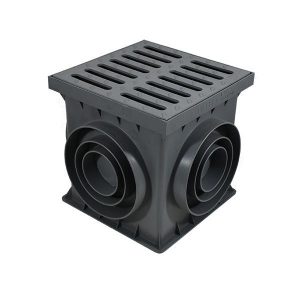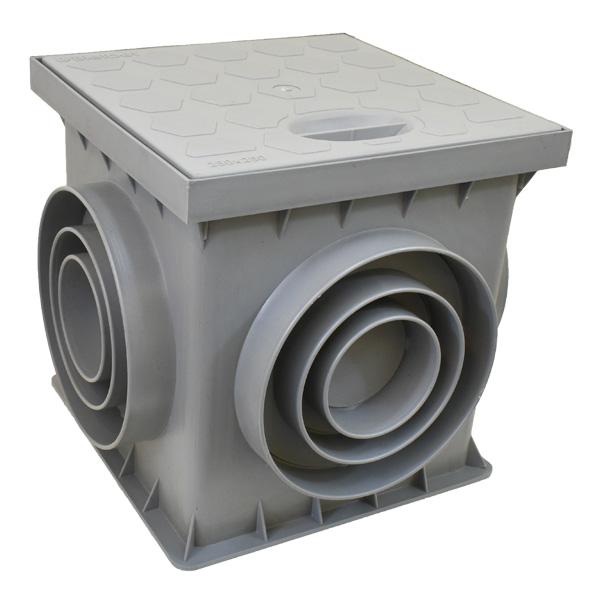Odwonienie liniowe pozwala szybko pozbyć się wody z powierzchni płaskich na posesji. Prosta i szybka w montażu konstrukcja pozwoli na zachowanie stabilności terenu podwórka czy zabezpieczenie fundamentów domu przed wodą opadową. Jednym z ważnych elementów odwodnienia są studzienki podwórzowe. Czemu służą wpusty podwórzpwe i jak działają? O tym przeczytacie w dzisiejszym artykule.
Odwodnienie liniowe wokół domu
Układ odwodnienia liniowego budynku składa się przede wszystkim z korytek liniowych wyposażonych w ruszty, które mają za zadanie przejmować i odprowadzać wodę opadową z nieprzepuszczalnych powierzchni płaskich takich jak chodniki, podjazdy czy parkingi. Korytka odwodnienia liniowego układa się w miejscach szczególnie narażonych na zaleganie i gromadzenie się wody opadowej takich jak zagłębienia terenu. Korytko odprowadza wodę do sieci kanalizacji deszczowej lub ogólnospławnej. A także do układów rozsączających lub na tereny zielone. O tym jak działa odwodnienie, pisaliśmy już wcześniej. Układ odwodnienia liniowego może również wspierać układ rynnowy budynku, zwłaszcza w sytuacjach, w których niemożliwe jest połączenie rynien z układem drenarskim.
Studzienki podwórzowe – co to jest?
Studzienka podwórzowa służy do zbierania i odprowadzania wody opadowej z układów odwodnienia liniowego lub z rynien. Może też służyć za wpust punktowy na przykład w miejscowym zagłębieniu terenu lub pod wyjściem starej rynny czy pod kranem. Studzienka podwórzowa ma szczelny korpus wyposażony w króćce przyłączeniowe służące do odprowadzania zebranej wody deszczowej do dalszej instalacji. Może ona mieć pełną pokrywę lub kratkę wpustową. Ponadto niektóre modele posiadają kosz. Umożliwia on przechwytywanie zanieczyszczeń.
Studzienki podwórzowe dostępne w naszej ofercie mają korpusy wykonane z tworzyw sztucznych. Dostępne są modele z rusztami plastikowymi o klasie wytrzymałości A15 (ruch pieszy i rowerowy), a także takie z rusztami żeliwnymi wytrzymującymi ruch samochodów osobowych (klasa C250). Niektóre modele posiadają króćce umożliwiające połączenie z korytkami odwodnienia liniowego.

Gdzie stosuje się studzienki podwórzowe?
Studzienki podwórzowe najczęściej stosuje się jako samodzielny wpust, odbiornik wody z rynny lub połączenie układu odwodnienia liniowego z kanalizacją lub drenażem.
Studzienka podwórzowa może działać jako samodzielny wpust zbierający wodę z powierzchni i oddający go do odbiornika wody deszczowej. Dzieje się tak gdy konieczny jest odbiór wody z punktowego zagłębienia terenu lub jeśli brakuje miejsca do wykorzystania układu odwodnienia liniowego,
Studzienkę podwórzową stosuje się także, jeśli mamy do czynienia ze stałymi miejscami, z których należy odprowadzać wodę. Na przykład zakończenia rynien lub krany. Jeśli nie ma możliwości połączenia istniejących rynien z układem drenarskim, pod jej zakończeniem można umieścić studzienkę z rusztem. Pozwoli to na przechwycenie wypływającej z rynien wody bez rozlewania jej na powierzchniach nieprzepuszczalnych. Podobnie zadziała ona pod kranem ogrodowym.
Studzienki podwórzowe często łączy się z układami odwodnienia liniowego. W takich sytuacjach woda z korytek odprowadzana jest do studzienki, a następnie ze studzienki podwórzowej do dalszej instalacji.
Dobierając studzienkę do układu odwodnienia liniowego musimy upewnić się, że wybrane korytka będą kompatybilne ze studzienką. Studzienki podwórzowe i korytka odwodnienia liniowego mogą do siebie nie pasować jeśli są to systemy różnych producentów. W przypadku niektórych studzienek podwórzowych w celu połączenia ich z korytkami odwodnienia liniowego konieczne jest dokupienie dodatkowych elementów (np. Nadbudowa plastikowa do studzienki 300×300 H12mm).
Studzienki podwórzowe – zalety
[su_list icon=”icon: check” icon_color=”#538b5e”]
- Sprawne odprowadzanie wody deszczowej ma na celu zabezpieczenie i stabilizację gruntu wokół budynku i pod chodnikami oraz podjazdami. Jest to kluczowe dla bezpieczeństwa fundamentów, powierzchni utwardzonych i ścian budynków.
- Studzienka podwórzowa jest elementem prostym w montażu. Ponadto króćce przyłączeniowe znajdują się na wszystkich ściankach i łączą się z różnymi średnicami rur, co zapewnia wysoką wszechstronność produktu.
- Ponadto studzienka podwórzowa zapewnia dodatkową pojemność pozwalającą przechwycić wodę deszczową w deszczach nawalnych, co zwiększa skuteczność odwodnienia i zmniejsza szansę przepełnienia układów odwodnienia.
- Dodatkową zaletą studzienek jest to, że pozwalają na lepsze oczyszczenie przechwytywanej wody deszczowej przed przekazaniem jej do drenażu, zbiornika lub kanalizacji. Jest to szczególnie ważne przy odprowadzaniu wody do układu drenarskiego lub zbiornika rozsączającego. Jeśli do tych układów będzie napływać zanieczyszczona woda opadowa, doprowadzi to do zamulenia i zatkania układu.[/su_list]
Studzienka może być wyposażona w następujące elementy wspierające oczyszczanie wody: ruszt, kosz z sitem i korpus studzienki. Ruszt ma za zadanie zatrzymywać spływające z wodą opadową liście, igliwie, śmieci i inne większe obiekty. Mogą one bowiem zapchać układ odprowadzenia wody deszczowej. Korpus osadnika jest wyposażony w króćce odpływowe, które są umieszczone powyżej poziomu dna studzienki. Dzięki temu przestrzeń poniżej odpływu działa jak osadnik, który będzie zatrzymywał pył, piasek i inne frakcje cięższe od wody. Dodatkowo niektóre studzienki wyposażone są w kosz z sitem. Taki kosz spełnia najczęściej zarówno funkcję sita, jak i pomocniczego osadnika. Oznacza to, że zatrzymuje zarówno lekkie zanieczyszczenia takie jak liście i igliwie, które przedostały się przez ruszt studzienki, jak i piasek i pył, który będzie osiadał w koszu poniżej otworów sita. W celu zapewnienia poprawnego działania studzienki, należy ją okresowo czyścić. Jeśli studzienka lub sito przepełnią się zanieczyszczeniami, utracimy efekt oczyszczania wody opadowej w studzience.
Studzienka podwórzowa jest niezwykle przydatnym elementem. Może działać zarówno jako część składowa układu odwodnienia liniowego posesji, jak i samodzielny wpust. Umożliwia szybkie i bezproblemowe usuwanie wody deszczowej, jest prosta w montażu i eksploatacji i przynosi znaczne korzyści dla użytkowników.
